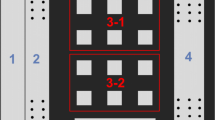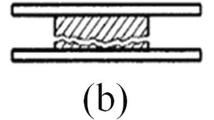Abstract
Nanoscale reinforcements are increasingly being used to improve mechanical, electrical and thermal behavior of polymers. In this study, the effects of reduced graphene oxide (RGO) epoxy filler on the tensile strength of adhesively bonded butt joints were investigated in a variety of environments. Firstly, dry butt joints with different RGO contents were tested using a uni-axial tensile test machine and it was observed that the joints reinforced with 0.5 wt.% RGO showed 22% higher strength than the joints without RGO reinforcements. Secondly, the effects of moisture, salt environment, and dry heat condition were investigated on the strength of the butt joints with different RGO contents. Results show that RGO particles significantly improve the strength values of the joints exposed to moist and dry heat conditions, but have less effect in salt environments.












Similar content being viewed by others
References
D.G. Lee, K.S. Jeong, K.S. Kim, Y.K. Kwak, Development of the anthropomorphic robot with carbon fiber epoxy composite materials. Compos. Struct. 25(1–4), 313–324 (1993)
T. Sadowski, P. Golewski, E. Zarzeka-Raczkowska, Damage and failure processes of hybrid joints: adhesive bonded aluminium plates reinforced by rivets. Comput. Mater. Sci. 50(4), 1256–1262 (2011)
S. Iijima, Helical microtubules of graphitic carbon. Nature 354(6348), 56–58 (1991)
E. Flahaut, A. Peigney, C. Laurent, C. Marliere, F. Chastel, A. Rousset, Carbon nanotube–metal–oxide nanocomposites: microstructure, electrical conductivity and mechanical properties. Acta Mater. 48(14), 3803–3812 (2000)
Y. Geng, M.Y. Liu, J. Li, X.M. Shi, J.K. Kim, Effects of surfactant treatment on mechanical and electrical properties of CNT/epoxy nanocomposites. Compos. A Appl. Sci. Manuf. 39(12), 1876–1883 (2008)
P.C. Ma, J.-K. Kim, B.Z. Tang, Functionalization of carbon nanotubes using a silane coupling agent. Carbon 44(15), 3232–3238 (2006)
J. Zhu, J. Kim, H. Peng, J.L. Margrave, V.N. Khabashesku, E.V. Barrera, Improving the dispersion and integration of single-walled carbon nanotubes in epoxy composites through functionalization. Nano Lett. 3(8), 1107–1113 (2003)
P. Karapappas, A. Vavouliotis, P. Tsotra, V. Kostopoulos, A. Palpetis, Enhanced fracture properties of carbon reinforced composites by the addition of multi-wall carbon nanotubes. J. Compos. Mater. 43, 977–985 (2009)
K.-D.S. Davey, Electronic Theses, Treatises and Dissertations Paper, 823, 2005
F.H. Gojny, M.H. Wichmann, B. Fiedler, K. Schulte, Influence of different carbon nanotubes on the mechanical properties of epoxy matrix composites—a comparative study. Compos. Sci. Technol. 65(15), 2300–2313 (2005)
S. Jana, W.-H. Zhong, Y.X. Gan, Characterization of the flexural behavior of a reactive graphitic nanofibers reinforced epoxy using a non-linear damage model. Mater. Sci. Eng. A 445, 106–112 (2007)
Y.J. Kim, T.S. Shin, Choi H. Do, J.H. Kwon, Y.-C. Chung, H.G. Yoon, Electrical conductivity of chemically modified multiwalled carbon nanotube/epoxy composites. Carbon 43(1), 23–30 (2005)
N. Yu, Z. Zhang, S. He, Fracture toughness and fatigue life of MWCNT/epoxy composites. Mater. Sci. Eng. A 494(1), 380–384 (2008)
M. Rahman, S. Zainuddin, M. Hosur, J. Malone, M. Salam, A. Kumar et al., Improvements in mechanical and thermo-mechanical properties of e-glass/epoxy composites using amino functionalized MWCNTs. Compos. Struct. 94(8), 2397–2406 (2012)
M.-H. Kang, J.-H. Choi, J.-H. Kweon, Fatigue life evaluation and crack detection of the adhesive joint with carbon nanotubes. Compos. Struct. 108, 417–422 (2014)
G. Gkikas, D. Sioulas, A. Lekatou, N. Barkoula, A. Paipetis, Enhanced bonded aircraft repair using nano-modified adhesives. Mater. Des. 41, 394–402 (2012)
J. Kim, B.-S. Yim, J.-M. Kim, J. Kim, The effects of functionalized graphene nanosheets on the thermal and mechanical properties of epoxy composites for anisotropic conductive adhesives (ACAs). Microelectron. Reliab. 52(3), 595–602 (2012)
U. Khan, P. May, H. Porwal, K. Nawaz, J.N. Coleman, Improved adhesive strength and toughness of polyvinyl acetate glue on addition of small quantities of graphene. ACS Appl. Mater. Interfaces 5(4), 1423–1428 (2013)
K.S. Novoselov, V. Fal, L. Colombo, P. Gellert, M. Schwab, K. Kim, A roadmap for graphene. Nature 490(7419), 192–200 (2012)
S. Abdolhosseinzadeh, H. Asgharzadeh, H.S. Kim, Fast and Fully-Scalable Synthesis of Reduced Graphene Oxide. Scientific Reports, 5, 2015.
K. Katnam, J. Stevenson, W. Stanley, M. Buggy, T. Young, Tensile strength of two-part epoxy paste adhesives: influence of mixing technique and micro-void formation. Int. J. Adhes. Adhes. 31(7), 666–673 (2011)
M. Frigione, M. Aiello, C. Naddeo, Water effects on the bond strength of concrete/concrete adhesive joints. Constr. Build. Mater. 20(10), 957–970 (2006)
P. Hu, X. Han, W. Li, L. Li, Q. Shao, Research on the static strength performance of adhesive single lap joints subjected to extreme temperature environment for automotive industry. Int. J. Adhes. Adhes. 41, 119–126 (2013)
S. Bertho, I. Haeldermans, A. Swinnen, W. Moons, T. Martens, L. Lutsen et al., Influence of thermal ageing on the stability of polymer bulk heterojunction solar cells. Sol. Energy Mater. Sol. Cells 91(5), 385–389 (2007)
Author information
Authors and Affiliations
Corresponding author
Rights and permissions
About this article
Cite this article
Saeimi Sadigh, M.A. Studying the Effect of Different Environmental Conditions on the Tensile Strength of RGO Reinforced Adhesively Bonded Butt Joints. J Fail. Anal. and Preven. 16, 1134–1140 (2016). https://doi.org/10.1007/s11668-016-0202-2
Received:
Revised:
Published:
Issue Date:
DOI: https://doi.org/10.1007/s11668-016-0202-2




